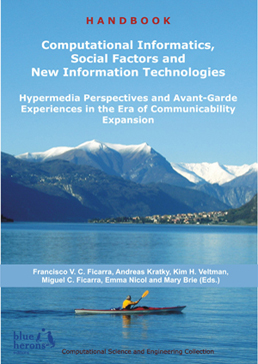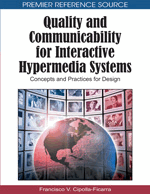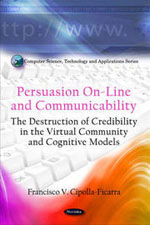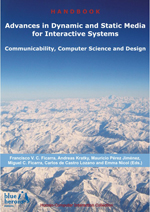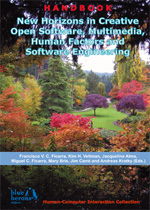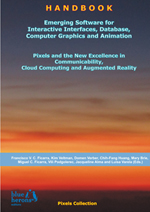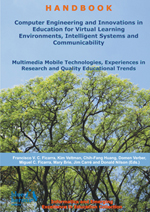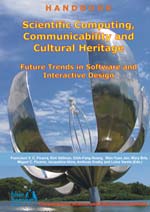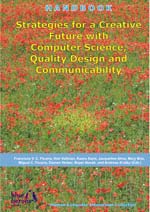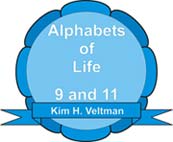Computational Informatics, Social Factors and New Information Technologies: Hypermedia Perspectives and Avant-Garde Experiences in the Era of Communicability Expansion
:: Computational Science and Engineering Collection ::
:: Revised Selected Chapters ::
Main Editor: Francisco V. C. Ficarra
Co-editors: Andreas Kratky (Los Angeles, USA), Kim H. Veltman (Maastricht, Netherlands), Miguel C. Ficarra (Italy and Spain), Emma Nicol (Glasgow, UK), and Mary Brie (La Valletta, Malta)
Editorial Assistant: Doris Edison (Vancouver, Canada)
Book Details
• ISBN: 978-88-96471-04-3 :: DOI: 10.978.8896471/043
• Publisher: Blue Herons Editions
• Location: Italy (Bg)
• Subjects: New Media, Security, Computer Games, Music Emotion, Software Engineering
• Subjects: Algorithmic Composition, Hypermedia, Immersion, Audiovisual Industry, Gamers
• Subjects: Education, Decision Rules, Fuzzy Systems, Gamification, Hardware, Interactions
• Subjects: Dynamic Programming, Technification, Human Factors, Music Feactures, TV
• Subjects: Neural Networks, Erlang Active Objects, Augmented Reality, Online Marketing
• Subjects: Ergonomics, Genetic Algorithms, Decision Trees, Communicability, Globalization
• Subjects: Internet, Computational Intelligence, Distributed System, Cyberculture, Sociology
• Copyright: 2011
• Collection: Computational Science and Engineering Collection
• Series volume: I
• Publication date: September, 2011
• Binding: Paperback
• Grade level: General
• Language: English
• Illustrations: Yes
• Colour: Yes
• Pages: 155
• Dimensions: 11.57x8.26x0.4 in. 1.38 lbs. :: 294x210x13 mm. 630 gr.
Preface
Brothers be united because that is the first law; have they a truthful union any time it may be, because if they fight among themselves will they be devoured by those from outside –Martín Fierro.
José Hernández (1834 - 1886)
Making a detailed analysis of the terms of the title of the current collection of scientific works we can understand the main goal, the secondary goals and the main areas encompassed in the current handbook. In this anchoring operation between the signifier and the signified (Saussure’s approach to language), in principle, to some the name “computational informatics”, for instance.
However, it is necessary to remember that not all automatic information needs to work with computers. The word “informatics” from a wide scientific point of view refers to the structure of the data, the process that turns these data into information, the feedback cycle, the communication of the information (both notions are not synonymous) and the use that is made of this information, among other things. In a few words, it is the use of computational methods and techniques in the information sciences.
Now the social factors refer to all those endpoints which currently influence the quality of the software and the interaction of the user with the interactive systems. Some factors that checkmate all the breakthroughs in software methodologies and its tools when they are not considered in the testing or design stage, for instance, especially when the generated products and/or services are global.
With regard to the notion of hypermedia it is considered as an intersection of media that use interactive systems on-line and/or off-line. Also the experiences in the information and communication technologies sector are included, without forgetting the breakthroughs that are generated daily in R+D area.
Finally, the expansion of the communicability era. Without any doubt a cornerstone of the current work, since we are immersed in the quality of the interactive communication, thanks to the evolution of traditional informatics towards microinformatics in McLuhan’s global village. A global village where the social networks play an important role to introduce changes in the daily lifestyle of millions of inhabitants and which along time may generate transformations in the working and social structures.
The second decade of the new millennium is laying the foundations of new ways of working which were already tested at the end of the 20th century and early 21st century. The reached results were very positive, along with the team work for the three-dimensional design of industrial components, for instance. A work which could be performed from the home (telework) and with members of the group scattered all around the planet. This simple example of interactive design on-line, which formerly was seldom used, is today the common denominator for this kind of computer-made activities.
Interactive design and the human factors are key in the development of the current interactive hypermedia systems. In the era of the expansion of interactive communicability it is important to have a compass to advance steadily in the right direction. An advance that must be shared by all the participants in the generation of of new interactive systems of microcomputing, such as multimedia phones, e-books, PC tablets, videogames, etc. These interactive products of the new millennium are based on the functional balance of computer science, electronics and telecommunications.
A balance that must be shared by all the people in the design, planning, production, implementation, quality control, the correction of the eventual mistakes, the attention to the potential users and/or clients, etc. Each one of the people who participates in the stages of the evolution of the product and/or service makes up the source of the human factors. That is, factors which sometimes are invisible but are vital for the success or the failure of the new services and products. As a rule, these novel products and/or services entail a long time of research and development. Knowing the human factors and software tools, improving the design of the interactive systems, icreasing ergonomics, etc. are basic tasks to avoid those agents that slow down or make it difficult to reach the maximum levels of quality, in the least possible time and with the lowest cost.
The current handbook is intended to be a first guideline for all those professionals of the new information and communication technologies. At the same time it has an interrelated bidirectional goal; to save costs to the manufacturers or entrepreneurs of the products/services of the latest technological generation and to evaluate the communicability of design. All of this is done to detect quickly the positive human and social factors (boosting them) and negative (wiping them out).
Several of the works that make up the book have been orally presented by their authors in the following international events in Córdoba, Argentina (HCITOCH 2011 –Second International Workshop on Human-Computer Interaction, Tourism and Cultural Heritage: Strategies for a Creative Future with Computer Science, Quality Design and Communicability), and Córdoba, Spain (CCGIDIS 2011 –First International Symposium on Communicability, Computer Graphics and Innovative Design for Interactive Systems). These works have been widened and reviewed again before being incorporated into the handbook. Next a short summary of each one of them:
Chih-Fang Huang and Chi-Fang Chu are the authors of the research work “Algorithmic Composition Using Rhythmic Complexity and Emotion Analysis”. In it is presented a melody generation system. They analyze a set of techniques and methods related to melody generation, based on composition algorithms, which have been positively verified. The user has the possibility of generating melodies in relation to his/her different moods, for instance. The statistic is present in the generation of the music algorithms. In few words, this research integrates emotion features with the algorithmic composition concept, and adds the rhythm complexity analysis result to not only enrich the computer generated music content, but also to create a novel and pioneer way to perform automated composition without complicated music parametric input, compared with the previous research.
In the chapter “New Information Technologies: Augmented Reality as a Social Factor”, its author, Oriol Camacho-Díaz, presents in the first instance a detailed study of the art on interactive connectivity without limits, particularly in the hypermedia devices belonging to the set of microcomputing with telecommunications and the social relationships which are created starting from them. An interesting group of examples allow one to have a 360º vision of the subjects presented. Besides, the author makes apparent the need that the mobile computer devices used in augmented reality have a common language in the globalization of the users, especially those that are aimed at the future generations.
The work “Dagger: A Tool for Analysis and Optimization of Decision Trees and Rules” has been made by the following authors Abdulaziz Alkhalid, Talha Amin, Igor Chikalov, Shahid Hussain, Mikhail Moshkov, and Beata Zielosko, where is presented the importance of counting with instruments at the moment of making decisions through a set of rules. These rules may be used to describe knowledge, knowing the algorithms and predictive multivariate models. In their work the authors masterfully present strategies to build a minimal complexity tree for a decision table. It is essential to point out that the authors resort to a set of solutions described in a form of graph which makes a sequential optimization relative to different complexity measures possible. All these premises have been successfully implemented in KAUST, which is a functional area of the system called Dagger. Currently the system is capable of quickly locating the exact solution to small and medium dimension problems (up to several dozens of attributes and thousands of rows, for instance). The chapter is completed with the results of the experiments made with Dagger.
The authors Emil Scarlat, Virginia Maracine, and Iulia Maries make known the details of their research work they present under the title “Computational Intelligence Techniques for Communities of Practice Network Formation”. This work demonstrates how the research is based on the theoretical approaches presented in the literature, with emphasis on applications of genetic algorithms. The work proposes a genetic algorithm for community formation related to intelligence. The approach introduces the concept of intelligence index, aiming to optimal partitions of a set of agents. Besides, along the text, there is a comprehensive description of the principles, challenges and methods of computational intelligence. Later on they are accompanied with a series of graphics and formulas, and each one of the main aspects of the evolution and development of communities of practice is unveiled. The authors also show the experiments they have made and the results reached in their work.
In the work titled “Internet as a Platform for the Promotion of the Audiovisual Sector in Andalusia” by their authors María del Mar Ramírez-Alvarado, María Ángeles Martínez-García, and Antonio Gómez-Aguilar explain the importance of the Andalusian audiovisual industry to generate jobs starting from the Internet. The authors show us each one of the aspects considered for the promotion of Andalusia, inside and outside Spain, with the marketing resources stemming from the Internet. There is an explanation of each one of the steps and strategies adopted, through the new mass media, real and virtual institutions, special events, etc. which generate contents related to the main and secondary goals of the developed project. In this project, the Internet takes a pivotal and priority role to reach all the planned goals. In these pages the different developed portals that have as their mission the promotion of Andalusia can be seen, whether it is from the local perspective or as regional or international.
The authors Noirin Curran and Jurek Kirakowski describe in their chapter “Immersion in Computer Games” the main aspects of role-playing games and the individuals who are involved with them. A detailed description of the word “immersion” allows us to know the special aspects of the motivation of the users when they interact with video games, for instance. There is a constant interrelation with the technologies of the videogames, users and the immersion notion, with which the authors encompass in a complete way the most varied standpoints that this triad entails. Additionally, the results obtained from the real observation of the players are presented, and the future research lines related to the immersion and interaction of the user with videogames.
The author Oriol Camacho-Díaz presents a work “Video Games: Towards Total Interaction”. This research is a wide ranging overview of the state of the art of video games, with an analysis of their evolution in the 20th century and beginning of the new millennium, both from the point of view of the hardware and the software. The stress of this work is on the total interaction of the user at the moment of the interaction. In this sense the main variables related to ergonomics are revealed. The main factors of cognitive psychology are also studied and some related to mass communication. The illustrations that accompany the text allow to have a more detailed view of the state of the art, developed step by step by the author.
Mario Fidelibus, in his chapter “Technification and Fashion Factor into Informatics Developments” explains to us an interesting point of view on the main problems which must be faced in the development of an informatics project, such as those operations that depend on technology or rather those that depend on a particular methodology. In the current work are presented several examples that are a guideline to detecting these situations, their relationships and which allow to make the best decisions. Additionally, the fashion factor is which has prevailed in certain periods of the evolution of computer science is considered. The author also makes an interesting and detailed diachronic analysis to complete the overall vision of the current work.
“A Security Model for Functional Active Objects with an Implementation in Erlang” is the title of the work presented by Andreas Fleck and Florian Kammüller. In this work, the authors describe a language-based security model for distributed computing based on functional active objects intended to build a basis for Distributed Information Flow Control (DIFC) and contrast it to earlier models, in particular the prominent model by Myers and Liskov. In a didactic way the authors put forward the motivations of the assumptions concerning secure communication in distributed object-oriented scenarios. Besides, more main aspects of the research will be revealed, which can be grouped and summed up in the following way: the notion of visibility, the security classes, and a definition of information-flow security for distributed active objects. Simultaneously, this chapter further describes how the concept can be realized using the novel tool box Erlang Active Objects for functional active objects. In this sense, the authors introduce Erlang and Erlang Active Objects. Through those the authors show how the model of decentralized multilateral security can be implemented by a simple algorithm for a dynamic security check for Erlang Active Objects.
In the chapter “Software Engineering Mirages”, an interesting study is presented of the forecasts made in the field of software engineering focusing on the question whether previously made forcasts (1990 - 2000) have actually been fulfilled as predicted or not. In it the forecasts made by Colin Potts, Victor Basili and John Musa are thoroughly analyzed. Starting from those a parallel is drawn with the current situation and some of the negative factors which daily inhibit the normal or logical evolution of software engineering. Also are revealed the consequences of such deviations with the example of the labour market in southern Europe. A large number of examples are presented to verify the destroyers of the theoretical and experimental premises, as a series of alternatives to solve the current crossroads that software engineering is going through and will go through in the future. In this way the contextual factors from the social perspective are considered, with special attention to human and sociological factors, just to mention two examples.
Francisco V. C. Ficarra
Vancouver, Canada (August 2011)
Partial Content On-line (pdf format)
• Front Cover (here)
• Preface :: Acknowledgment (here)
• Chapters :: Final Remarks :: Author Index :: Keywords Index :: References ... (here)
• Back Cover (here)
Additonal Handook Info
• Only paper copy – no digital book on-line and/or off-line –
• Special Price € 95 (expedition cost not included) ... e-Commerce :: Info Form
Welcome to Blue Herons Editions!
The origin of this publishing project is to be found in the Canadian lands, where nature presents itself generous in many places of its wide geography. More...
Education, Communicability, Design, Computer Science, HCI, Computer Graphics and Computer Animation:
We focus on education and new technologies with 31 years long experience. More...
Literature and Journalism:
Intersection between universal literature, local new journalism (true stories), sociology and legal immunity. Two collections:
- Casoncelli Bergamaschi
It is a typical bergamasque dough filled with meat, similar to the raviolis. More...
- Menjar Blanc & Black
It is a typical sweet of the Catalan coast and the Balearic Islands. More...
Others New Releases:
See all others new releases in books, CD, DVD, etc. More ...
Call for Papers: ADNTIIC 2015 :: HCITOCH 2015 :: SETECEC 2015 :: HIASCIT 2015 :: CCGIDIS 2015 :: IPCTIIC 2015 | HCITISI 2015 :: MSIVISM 2015 :: RDINIDR 2015

